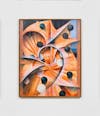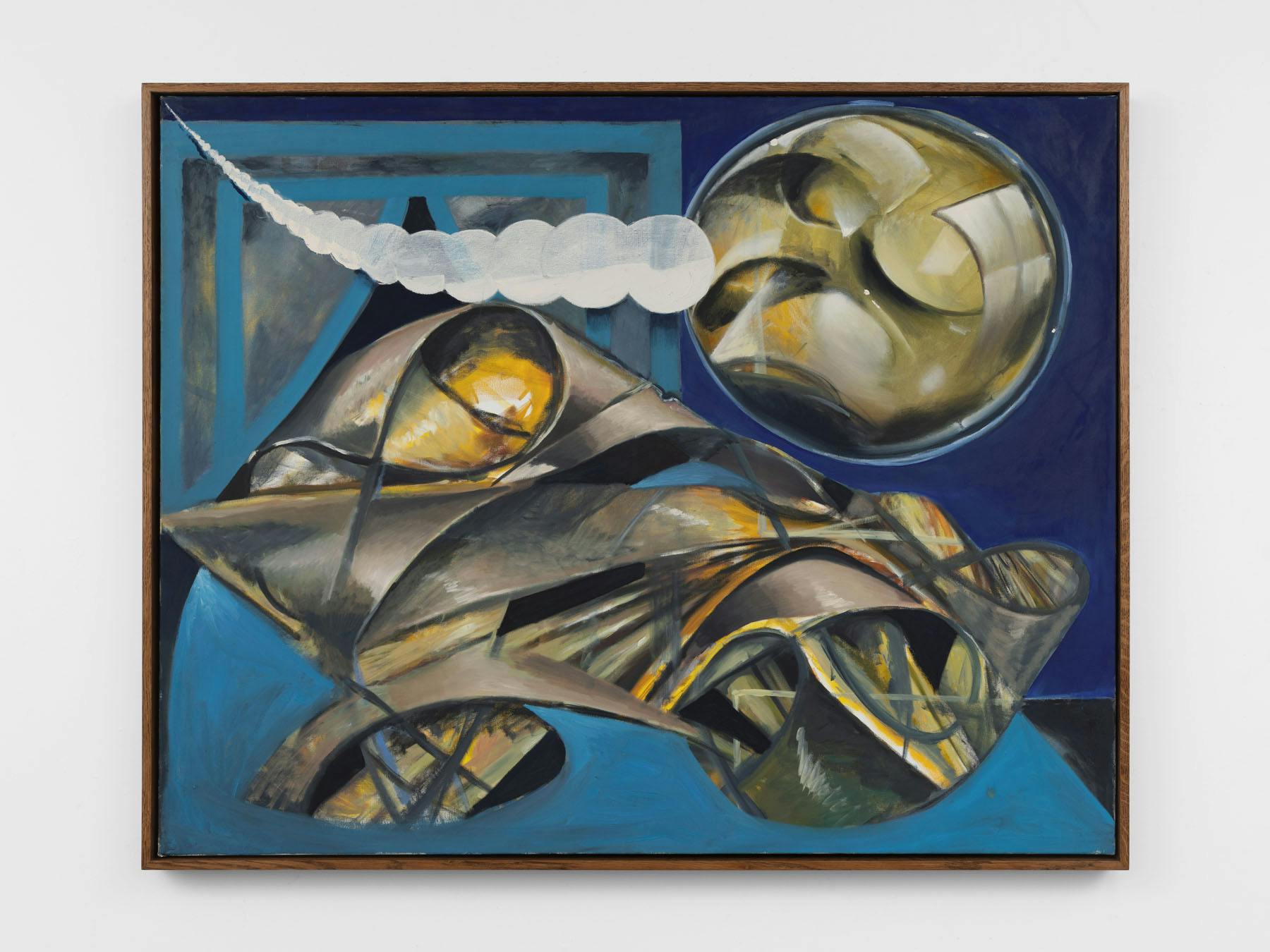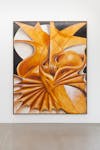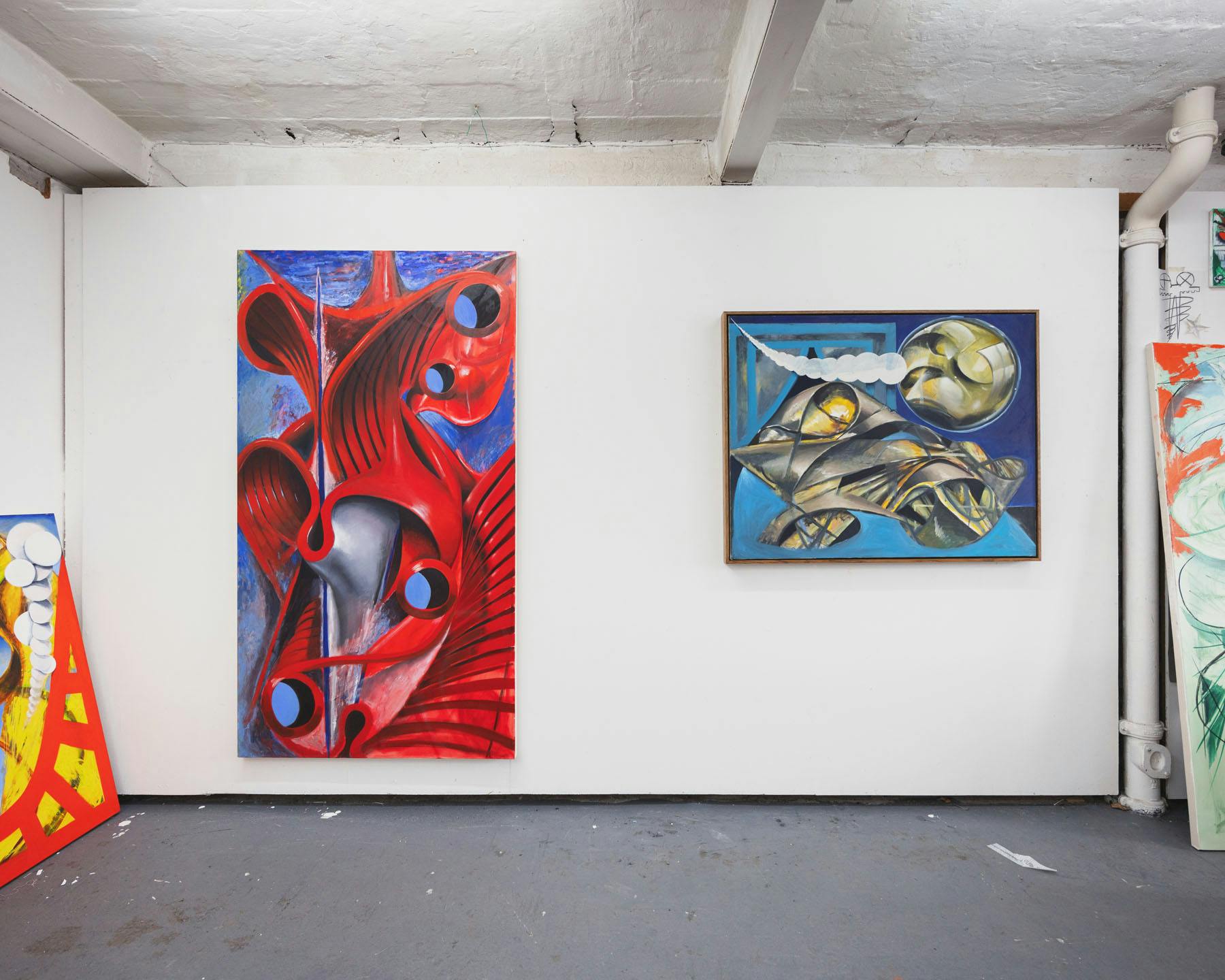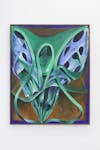In his East London studio, like a vigorous conductor of an orchestra, Sean fluctuates tempos, cues his infinite ensemble of shapes, and all the while steadies the flow of paint, his brush the baton of control. Unlike a conductor, whose role is to keep consistent rhythm, Sean prefers his melodies more awry – taking turns, pauses, loops or segues in another direction altogether. He works under these terms to keep the process open. The holes and passageways in his paintings can be viewed as metaphors for his absorption into plunging the unknown. The helix-like shapes that roam each canvas often repeat in on themselves, digging more trap-doors for us to fall through.
Sean looks to science or philosophy for inspiration. His recent fixation is ‘Assembly theory’ – a method devised to break down molecules into their smallest components and counting the number of unique parts. It was developed to investigate potential extraterrestrial life, and is just one of many abstruse theories Sean reads to make sense of the world: a longer, broader take. His hinterlands are intentionally complex, too, as he asks ‘imagine what aliens would think of art?’ The paintings take a deep dive into intuition – some marks that faintly allude to the sharp peaks of fish gills, or the ripples of a bird’s wing in flight, but merged against a cacophony of pure abstraction. Some of his visual references equally combine abstract gestures merged with cogitations about nature: a hulking elephant skull owned by , marble animal horns cocooned in leather petals by or an etching of clouds by . Sean constantly mines for more, only content once every avenue of the canvas is exhausted, ‘keeping the paintings open for as long as they can be’ as he lingers on a few at a time – dwelling in decisions and doubts. Like a scientist experimenting in a lab, he strives for surprise, and drawing on techniques founded by the Cubists in the early-20th-century; breaking down and reassembling forms with charcoal abrasions or heightened shadow. Painting for Sean is a game of choices, each move leaving an indelible trail.
But before mixing his paints, he makes charcoal sketches on sheets of , the thick black marks reminiscent of artist Lee Lozano’s mid-century studies of tools and machinery. Sean’s forms vary between sharper utensils to more rounded horseshoes, each study adding to a growing catalogue of glyphs he’ll return to when inspiration and inclination combine. The freedom he feels for drawing, smudging and scratching at the pages to build up layers, he’ll emulate in paint, too – each canvas a continual ground for change and revision, with the fluidity of natural life itself. At random, he starts by applying a single colour from his trolley of paints, doodling a rough path with his brushes. He’ll then plant areas of oils, applying swathes with brushes or a pallet knife, before pruning his marks with strewn bits of cloth. The process flows like the ticking of a metronome, until he works back into the surface, a pause – his molecules of marks mutating with every flurried burst. Pastels and charcoal start to nudge their way back in, shadowing or emphasising the painted marks above as if he’s back at the sketch pad drawing again.
Since his paintings begin in monochrome, Sean’s bank of research images is too – the references all have a bleached, washed out tinge. It’s a ploy for him to understand the shapes and outlines of things, without the distraction of colour, context or atmosphere. Such is his effervescence, research leads him up a number of avenues. Architecture: Bruno Taut’s in Cologne and a model for the by Louis Kahn. Science, of course: the abrasive skin of a shark under a and a mud bubble found next to a . Sculpture: a stack of rocks by or Philip King’s steel and fibreglass . Sean’s acute, forensic awareness for nature, and specifically human kind’s placement within it, means these seemingly disparate influences widen his reach, deepening the paintings. He’s fascinated by a process in computer science called ‘recursion’, of defining a problem in terms of a simpler version of itself. Although his paintings are seldom simplified, breaching every inch of canvas with brisk marks, he’s continually solving propositions directly onto the surface. You’ll notice some shapes repeat in on themselves or connect through a circuit he’s sketched at the outset – no marks entirely dismissed. The painting game continues; knowing when to stop or carry on. The exits are always present, but always met with obstacles of curves, spirals and folds that keep him, and us, compelled for longer.
Sean Steadman (born Chelmsford, Essex) lives and works in London. Selected exhibitions include: Cascade, Project Native informant (2021), After Image, Mamoth (2020), 1, 000,000,000,000, Project Native Informant(2020), The Sleeping Procession Cass Sculpture Center(2017), Lived in, Galeri Opdahl (2017)
References
1
2
3
4
5
6
7
8
9
10
Sean Steadman, Axioms
March 04 – April 26, 2022

